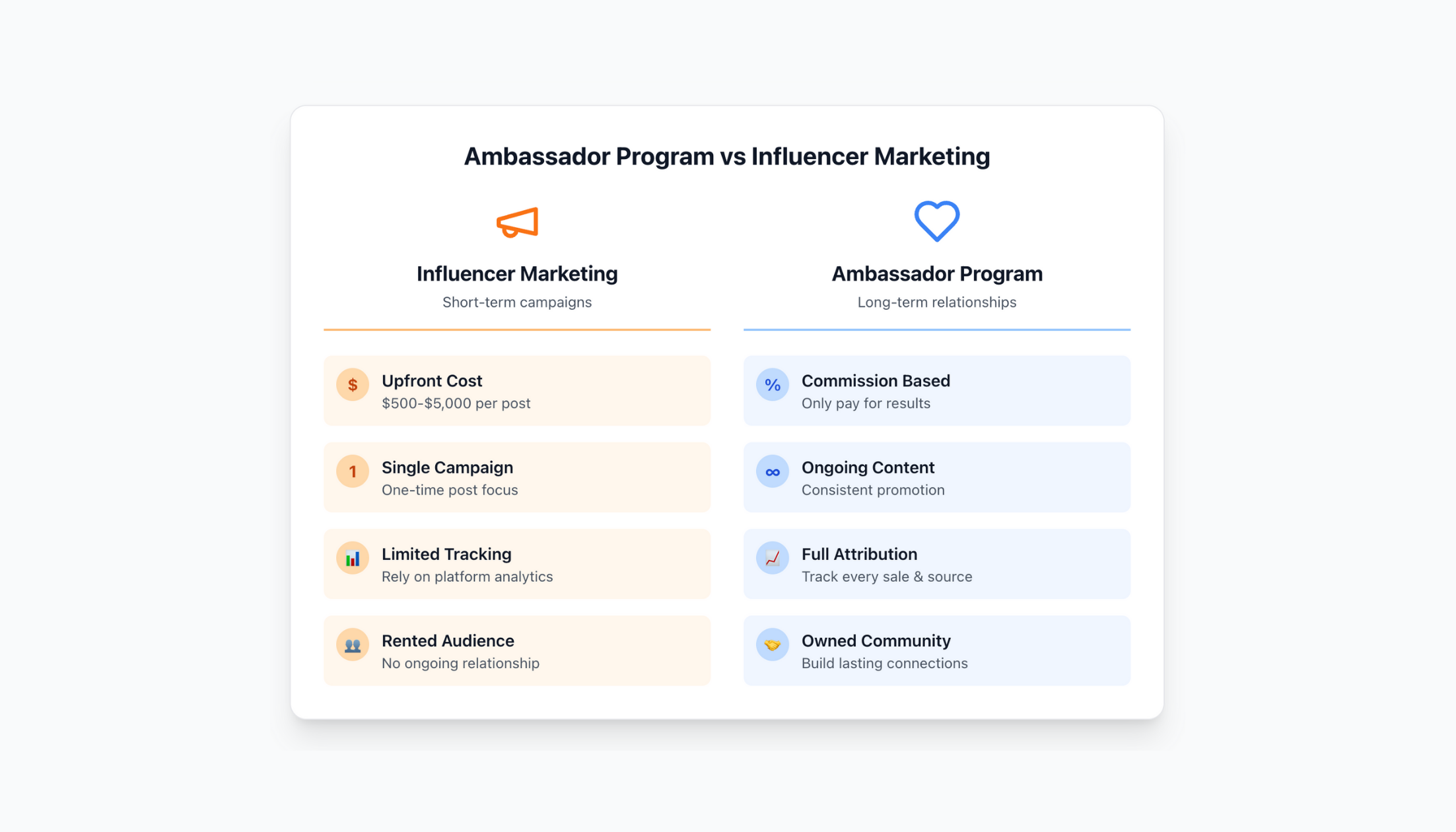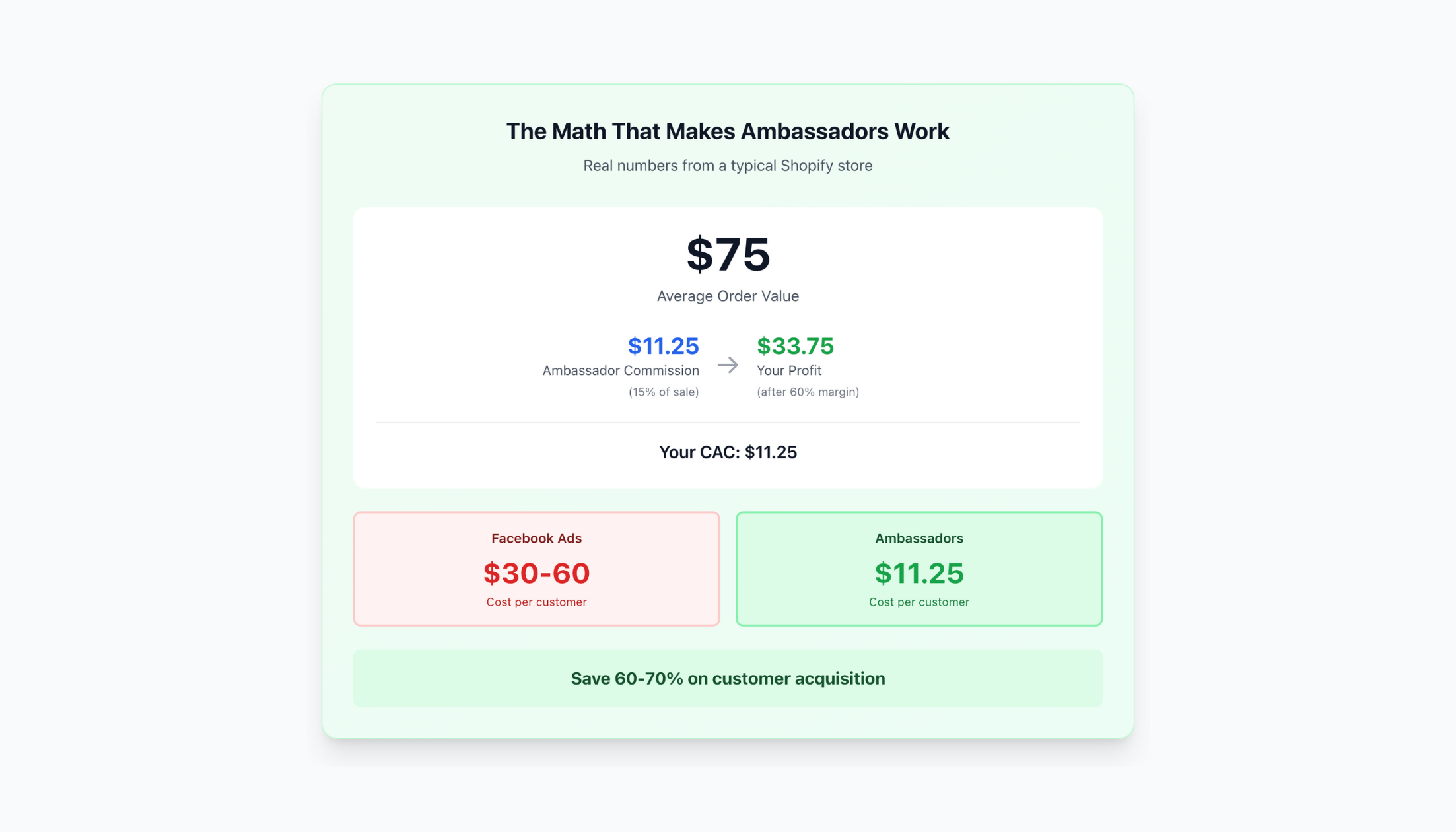.png)
How to Start a Shopify Ambassador Program (And Why You Should)
If you're running a Shopify store and feeling the squeeze from rising ad costs, here's something worth considering: your best customers are probably already recommending your products to their friends. For free.
An ambassador program turns that word-of-mouth into an actual growth channel you can track and scale. This guide will walk you through what ambassador programs actually are, why they work better than one-off influencer posts, and how to set one up without drowning in spreadsheets.
What Makes Ambassador Programs Different

Ambassador programs aren't just influencer marketing with a different name. The difference comes down to authenticity and longevity.
When you hire an influencer for a sponsored post, you're renting their audience for a day. They post, you get a spike in traffic, and that's it. You're also competing with every other brand paying them, and their followers know it's an ad.
Ambassadors are different. They're customers who genuinely use and love your products. They promote your brand because they want to, not just because you paid them. And instead of one post, they create content over weeks and months, building real trust with their audience.
The economics work better too. With influencer posts, you're paying $500-$5,000 upfront with no guarantee of sales. With ambassadors, you typically pay commission only when they drive actual revenue. Lower risk, better ROI.
The Basic Math That Makes This Work

Let's say you sell a product with a $75 average order value and a 60% profit margin.
You set up an ambassador program with a 15% commission structure. When an ambassador drives a sale, they earn $11.25 and you keep $33.75 in profit after product costs. Your customer acquisition cost is $11.25.
Compare that to Facebook ads where you're paying $30-60+ per customer, and the math starts looking really attractive.
The compounding effect is what makes this powerful. Each month you recruit a few more ambassadors. Each ambassador's audience overlaps slightly with others, creating network effects. By month six, you might have 50-100 people consistently driving sales without you touching an ad dashboard.
How to Structure Commissions (Without Overcomplicating It)
Most brands overthink this. Here's what actually works:
For products with 50-70% margins: Pay 10-15% commission on sales. Simple, clean, easy to explain.
For digital products or high-margin items: You can be more generous with 20-25% since your costs are lower.
For lower-margin products: Stick to 5-10% commission, but supplement with free products, early access to new releases, or milestone bonuses.
One important detail: calculate commission on the post-discount sale amount. If an ambassador gives someone 15% off a $100 order, commission is calculated on $85, not $100. This keeps your margins healthy.
Avoid complicated tier structures when you're starting out. You can add performance tiers later once you have 25+ ambassadors and actual data on what motivates them.
Your First 30 Days: The Practical Setup
Week 1: Get your infrastructure ready
Install Buzzbassador and connect it to your Shopify store. Set your commission rate. Create your application form—keep it short with 5-6 questions. You want to know their Instagram handle, why they like your brand, and maybe their follower count (though small followings are fine if they're engaged).
Build a simple welcome email that new ambassadors receive when accepted. Include their unique discount code, explain how commissions work, and give them 2-3 content ideas to get started. Make it feel special—they should be excited they got in.
Week 2: Find your first ambassadors
Start with your existing customers. Export anyone who's ordered 2+ times and email them directly. Your conversion rate here will be 10-20% because these people already love your products.
Search your brand mentions on Instagram and TikTok. Find people who've posted about you organically and DM them: "Hey! Loved your post about [product]. We're building our ambassador program—want in?"
Send an email to your most engaged subscribers with a subject like "Want to earn money sharing products you already love?" Include your application link.
Your goal is 20-30 applications by end of week two.
Week 3: Launch with a simple campaign
Accept your first 10-15 ambassadors. Send welcome emails. Then immediately give them something to do.
Launch a simple first campaign: "Share an unboxing or product review this week and everyone who completes it gets $25 in store credit." This gets people creating content immediately instead of sitting idle.
Week 4: Check what's working
Look at who's driving sales and what type of content is performing. Reach out to ambassadors who haven't posted yet—sometimes they just need a nudge or some product photos to work with.
Plan your campaign for month two and recruit another 10-15 ambassadors.
The Content That Actually Converts

Don't just tell ambassadors to "post about us." Give them specific ideas:
Unboxing videos work because new customers want to see what they'll actually receive. These perform well as Instagram Reels or TikToks.
Before/after content is perfect if your product creates visible results—skincare, organization products, fitness gear.
"Get ready with me" videos where your product is naturally incorporated into their routine feel authentic and show real use cases.
Comparison posts where they explain why they switched from a competitor address objections and work great as carousel posts.
The key is giving ambassadors enough structure that they're not staring at a blank canvas, but enough freedom that their content still feels authentic to them.
Three Mistakes That Kill Programs Early
Mistake 1: Accepting everyone who applies. Quality beats quantity. One engaged ambassador who posts twice a month beats ten inactive ones. Look for genuine enthusiasm in applications and check if they actually post consistently.
Mistake 2: Setting it and forgetting it. Your ambassadors need regular touchpoints. Send weekly or biweekly updates, celebrate wins, run monthly campaigns. If you go silent, they will too.
Mistake 3: Slow payouts. Nothing kills motivation like waiting forever to get paid. Set up a clear monthly payout schedule and stick to it religiously.
Why In-House Tracking Matters
Here's what happens without proper tracking: You're managing discount codes in a spreadsheet. Ambassadors are DMing you screenshots. You're manually calculating commissions. Someone uses the wrong code. It's a mess.
Buzzbassador connects directly to your Shopify store and syncs everything automatically—orders, discount codes, affiliate links. You see exactly who's driving sales, what they've earned, and your program ROI in real-time. No manual entry, no broken tracking, no spreadsheet hell.
The native Shopify integration means ambassador-driven orders flow through just like any other order, but with proper attribution. When it's time to pay commissions, you can set up automated PayPal payouts instead of manually sending dozens of individual payments.
Is This Actually Worth Your Time?
Ambassador programs aren't magic. They won't replace your entire marketing strategy. But they create a sustainable growth channel that compounds over time and costs less than paid ads.
They work best for brands that already have happy customers, decent product margins, and products people naturally want to share. They struggle if you're brand new with zero traction, or if your products are boring or embarrassing to talk about.
The first 90 days require real effort—you're building relationships and systems from scratch. But once you have 30-50 active ambassadors, the program maintains itself with a few hours of management per week.
Most Shopify brands see their first sales within two weeks of onboarding ambassadors. Real momentum builds in months 2-3 when you have enough ambassadors that multiple posts are going out every week.
Getting Started
Buzzbassador's free Launch plan gives you everything you need to start: unlimited ambassadors, custom application forms, automatic tracking, and real-time reporting. No credit card required.
The setup takes about an hour. Recruiting your first 10 ambassadors takes another week. By day 30, you could have real revenue coming through a channel you actually own.
Start free with Buzzbassador →
FAQ
How much should I pay in commissions? Start with 10-15% for physical products with decent margins. You can always adjust up or down based on what motivates your ambassadors and what your margins can handle.
What if my ambassadors stop posting? Normal—expect 40-60% of ambassadors to be active in any given month. Combat this with monthly campaigns, surprise product drops to top performers, and regular check-ins.
Do I need big influencers? No. Micro-influencers (1K-10K followers) often convert better because they have more engaged audiences. Focus on enthusiasm and content quality over follower count.
How long until I see results? Some brands see first sales within 30 days. Meaningful momentum builds in months 2-3 when you have 25-50 active ambassadors consistently posting.All Images

.png)
.png)


